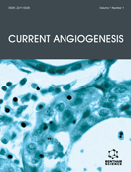Abstract
Background/Objective: The role of circulating endothelial cells in tumor progression was noted by many researchers. The purpose of this research was to study the relationship of free (unrelated to the wall of vessel) CD34 positive cells (F-CD34+) located in the lumen of tumor vessels with features of angiogenesis, clinical and morphological characteristics of breast cancer (BC).
Materials and Methods: The tumor samples received from 45 patients with T1-T2 stages of ductal invasive carcinomas were included in this study. The sections were stained immunohistochemically using antibodies to CD34. The presence of F-CD34+ was assessed microscopically and compared with clinical characteristics of BC, hormone receptors and HER2/neu status, with the number of different tumor vessels and with the presence of lymphovascular invasion (LVI).
Results: F-CD34+ were revealed in 35 cases (77,8%). Their presence correlated with the number of atypical dilated capillaries (p=0.00001) and “cavitary” structures (CS) type-1 (p=0,001) having been described by us earlier, with the presence of LVI (p=0,02), tumor grade (p=0,01), estrogen receptor (p=0,0002) and progesterone receptor (p=0,002) status. FCD34+ were more often observed in the cases with multiple atypical dilated capillaries (p=0,001) and CS type-1 (p=0,04), in the presence of LVI (p=0,1), in G2-G3 (p=0,09), in negative estrogen (p=0,01) and progesterone (=0,03) receptors status. The correlations of F-CD34+ with Her2/new status, microvessel density and other types of tumor vessels were not detected.
Conclusion: The presence of F-CD34+ in tumor vessels is associated with clinical, morphological and biological characteristics of BC and its evaluation may be important for the prognosis.
Keywords: breast cancer, angiogenesis, tumor vessels, circulating endothelial cells, hormone receptors status, lymphovascular invasion.
 34
34


